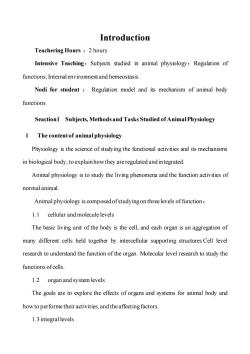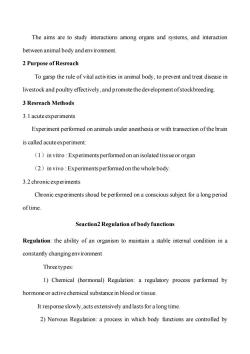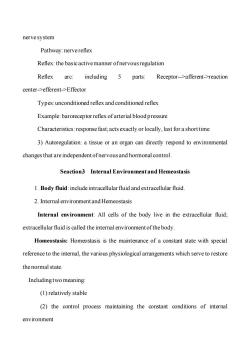佛山大学(佛山科学技术学院):《动物生理学》课程教学资源(授课教案,英文版)绪论 Animal physiology

Introduction Teachering Hours 2 hours Intensive Teaching:Subjects studied in animal physiology:Regulation of functions;Internal environment and hemeostasis. Nodi for student Regulation model and its mechanism of animal body functions. Seaction1 Subjects,Methods and Tasks Studied of Animal Physiology The content of animal physiology Physiology is the science of studying the functional activities and its mechanisms in biological body,to explain how they are regulated and integrated. Animal physiology is to study the living phenomena and the function activities of normal animal. Animal physiology is composed ofstudying on three levels of function: 1.1 cellular and molecule levels The basic living unit of the body is the cell,and each organ is an aggregation of many different cells held together by intercellular supporting structures.Cell level research to understand the function of the organ.Molecular level research to study the functions ofcells. 1.2 organ and system levels The goals are to explore the effects of organs and systems for animal body and how to performe their activities,and the affecting factors. 1.3 integral levels
Introduction Teachering Hours :2 hours Intensive Teaching:Subjects studied in animal physiology;Regulation of functions; Internal environment and hemeostasis. Nodi for student : Regulation model and its mechanism of animal body functions. Seaction1 Subjects, Methods and Tasks Studied of Animal Physiology 1 The content of animal physiology Physiology is the science of studying the functional activities and its mechanisms in biological body, to explain how they are regulated and integrated. Animal physiology is to study the living phenomena and the function activities of normal animal. Animal physiology is composed of studying on three levels of function: 1.1 cellular and molecule levels The basic living unit of the body is the cell, and each organ is an aggregation of many different cells held together by intercellular supporting structures.Cell level research to understand the function of the organ. Molecular level research to study the functions of cells. 1.2 organ and system levels The goals are to explore the effects of organs and systems for animal body and how to performe their activities, and the affecting factors. 1.3 integral levels

The aims are to study interactions among organs and systems,and interaction between animal body and environment. 2 Purpose of Resreach To garsp the rule of vital activities in animal body,to prevent and treat disease in livestock and poultry effectively,and promote the development ofstockbreeding. 3 Resreach Methods 3.1 acute experiments Experiment performed on animals under anesthesia or with transection of the brain is called acute experiment: (1)in vitro:Experiments performed on an isolated tissue or organ (2)in vivo:Experiments performed on the whole body. 3.2 chronicexperiments Chronic experiments shoud be performed on a conscious subject for a long period oftime. Seaction2 Regulation of body functions Regulation:the ability of an organism to maintain a stable internal condition in a constantly changing environment Three types: 1)Chemical (hormonal)Regulation:a regulatory process performed by hormone or active chemical substance in blood or tissue. It response slowly,acts extensively and lasts for a long time. 2)Nervous Regulation:a process in which body functions are controlled by
The aims are to study interactions among organs and systems, and interaction between animal body and environment. 2 Purpose of Resreach To garsp the rule of vital activities in animal body, to prevent and treat disease in livestock and poultry effectively, and promote the development of stockbreeding. 3 Resreach Methods 3.1 acute experiments Experiment performed on animals under anesthesia or with transection of the brain is called acute experiment: (1)in vitro : Experiments performed on an isolated tissue or organ (2)in vivo : Experiments performed on the whole body. 3.2 chronic experiments Chronic experiments shoud be performed on a conscious subject for a long period of time. Seaction2 Regulation of body functions Regulation: the ability of an organism to maintain a stable internal condition in a constantly changing environment Three types: 1) Chemical (hormonal) Regulation: a regulatory process performed by hormone or active chemical substance in blood or tissue. It response slowly, acts extensively and lasts for a long time. 2) Nervous Regulation: a process in which body functions are controlled by

nerve system Pathway:nerve reflex Reflex:the basic active manner ofnervous regulation Reflex arc: including 5 parts: Receptor-->afferent->reaction center->efferent->Effector Types:unconditioned reflex and conditioned reflex Example:baroreceptor reflex ofarterial blood pressure Characteristics:response fast;acts exactly or locally,last for a short time 3)Autoregulation:a tissue or an organ can directly respond to environmental changes that are independent ofnervous and hormonal control. Seaction3 Internal Environment and Hemeostasis 1.Body fluid:include intracellular fluid and extracellular fluid 2.Internal environment and Hemeostasis Internal environment:All cells of the body live in the extracellular fluid; extracellular fluid is called the internal environment of the body. Homeostasis:Homeostasis is the maintenance of a constant state with special reference to the internal,the various physiological arrangements which serve to restore the normal state. Includingtwo meaning: (1)relatively stable (2)the control process maintaining the constant conditions of internal environment
nerve system Pathway: nerve reflex Reflex: the basic active manner of nervous regulation Reflex arc: including 5 parts: Receptor-->afferent->reaction center->efferent->Effector Types: unconditioned reflex and conditioned reflex Example: baroreceptor reflex of arterial blood pressure Characteristics: response fast; acts exactly or locally, last for a short time 3) Autoregulation: a tissue or an organ can directly respond to environmental changes that are independent of nervous and hormonal control. Seaction3 Internal Environment and Hemeostasis 1. Body fluid: include intracellular fluid and extracellular fluid. 2. Internal environment and Hemeostasis Internal environment: All cells of the body live in the extracellular fluid; extracellular fluid is called the internal environment of the body. Homeostasis: Homeostasis is the maintenance of a constant state with special reference to the internal, the various physiological arrangements which serve to restore the normal state. Including two meaning: (1) relatively stable (2) the control process maintaining the constant conditions of internal environment

Function:All of the organs and tissues perform function to help maintain these constant conditions
Function: All of the organs and tissues perform function to help maintain these constant conditions
按次数下载不扣除下载券;
注册用户24小时内重复下载只扣除一次;
顺序:VIP每日次数-->可用次数-->下载券;
- 佛山大学(佛山科学技术学院):《动物生理学》课程教学资源(授课教案,中文版)第12章 泌乳.doc
- 佛山大学(佛山科学技术学院):《动物生理学》课程教学资源(授课教案,中文版)第11章 繁殖.doc
- 佛山大学(佛山科学技术学院):《动物生理学》课程教学资源(授课教案,中文版)第9章 神经系统.doc
- 佛山大学(佛山科学技术学院):《动物生理学》课程教学资源(授课教案,中文版)第10章 内分泌.doc
- 佛山大学(佛山科学技术学院):《动物生理学》课程教学资源(授课教案,中文版)第8章 肌肉.doc
- 佛山大学(佛山科学技术学院):《动物生理学》课程教学资源(授课教案,中文版)第7章 泌尿.doc
- 佛山大学(佛山科学技术学院):《动物生理学》课程教学资源(授课教案,中文版)第6章 能量代谢与体温.doc
- 佛山大学(佛山科学技术学院):《动物生理学》课程教学资源(授课教案,中文版)第5章 消化与吸收.doc
- 佛山大学(佛山科学技术学院):《动物生理学》课程教学资源(授课教案,中文版)第4章 呼吸.doc
- 佛山大学(佛山科学技术学院):《动物生理学》课程教学资源(授课教案,中文版)第3章 循环生理.doc
- 佛山大学(佛山科学技术学院):《动物生理学》课程教学资源(授课教案,中文版)第2章 血液.doc
- 佛山大学(佛山科学技术学院):《动物生理学》课程教学资源(授课教案,中文版)第1章 细胞生理.doc
- 佛山大学(佛山科学技术学院):《动物生理学》课程教学资源(授课教案,中文版)绪论 Animal physiology.doc
- 佛山大学(佛山科学技术学院):《动物生理学》课程教学资源(英文讲义,打印版)Animal physiology.pdf
- 佛山大学(佛山科学技术学院):《动物生理学》课程教学资源(习题库,含答案).doc
- 佛山大学(佛山科学技术学院):锌缺乏症(PPT课件讲稿)Zinc Deficiency.pdf
- 佛山大学(佛山科学技术学院):皱胃阻塞(PPT课件讲稿)Impaction-of-Abomasum.pdf
- 四川农业大学:我国养鸡生产现状与发展趋势分析(PPT专题报告,主讲:朱庆).ppt
- 新疆农业大学:世界马品种中文命名标准 Chinese Naming Standard for Horse Breeds of the World.pdf
- 西藏农牧学院:《饲草饲料加工与贮藏学 Processing and Storing of Forage》课程教学资源(PPT课件讲稿)绪论(苗彦军).ppt
- 佛山大学(佛山科学技术学院):《动物生理学》课程教学资源(授课教案,英文版)第1章 细胞生理.doc
- 佛山大学(佛山科学技术学院):《动物生理学》课程教学资源(授课教案,英文版)第2章 血液.doc
- 佛山大学(佛山科学技术学院):《动物生理学》课程教学资源(授课教案,英文版)第3章 循环生理.doc
- 佛山大学(佛山科学技术学院):《动物生理学》课程教学资源(授课教案,英文版)第4章 呼吸.doc
- 佛山大学(佛山科学技术学院):《动物生理学》课程教学资源(授课教案,英文版)第5章 消化与吸收.doc
- 佛山大学(佛山科学技术学院):《动物生理学》课程教学资源(授课教案,英文版)第6章 能量代谢与体温.doc
- 佛山大学(佛山科学技术学院):《动物生理学》课程教学资源(授课教案,英文版)第7章 泌尿.doc
- 佛山大学(佛山科学技术学院):《动物生理学》课程教学资源(授课教案,英文版)第8章 肌肉.doc
- 佛山大学(佛山科学技术学院):《动物生理学》课程教学资源(授课教案,英文版)第10章 内分泌.doc
- 佛山大学(佛山科学技术学院):《动物生理学》课程教学资源(授课教案,英文版)第9章 神经系统.doc
- 佛山大学(佛山科学技术学院):《动物生理学》课程教学资源(授课教案,英文版)第11章 繁殖.doc
- 佛山大学(佛山科学技术学院):《动物生理学》课程教学资源(授课教案,英文版)第12章 泌乳.doc
- 佛山大学(佛山科学技术学院):《动物生理学》课程教学资源(PPT课件,中文版)绪论 Animal physiology(主讲:王丙云).ppt
- 佛山大学(佛山科学技术学院):《动物生理学》课程教学资源(PPT课件,中文版)第1章 细胞生理 Cellular physiology.ppt
- 佛山大学(佛山科学技术学院):《动物生理学》课程教学资源(PPT课件,中文版)第2章 血液.ppt
- 佛山大学(佛山科学技术学院):《动物生理学》课程教学资源(PPT课件,中文版)第10章 内分泌.ppt
- 佛山大学(佛山科学技术学院):《动物生理学》课程教学资源(PPT课件,中文版)第11章 繁殖.ppt
- 佛山大学(佛山科学技术学院):《动物生理学》课程教学资源(PPT课件,中文版)第12章 泌乳.ppt
- 佛山大学(佛山科学技术学院):《动物生理学》课程教学资源(PPT课件,中文版)第3章 循环生理(血液循环 Blood circulation).ppt
- 佛山大学(佛山科学技术学院):《动物生理学》课程教学资源(PPT课件,中文版)第4章 呼吸 Respiration.ppt
